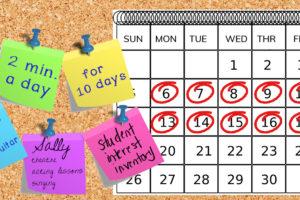Have you ever tried to follow your own directions? Picture this scene:
A class of 28 energetic and excited 8-year-olds arrives at the music room. A teacher, standing at the doorway ready to greet them, gives these directions to her primary grade students as they enter the classroom.
Teacher:
Good morning, class! Shhhh! I want you to come in quietly and find your place on the floor. Make sure you get your carpet square. Shhhh! If you look at the board, you will see the activities we are doing today. Remember, come in quietly. I told you, Johnny, to find your seat on the floor. Don’t fight over the carpet squares! There are plenty. Quiet, class! No we aren’t playing the instruments today. We will be dancing. Look at the board. Come sit on the floor, everyone.
This scene continues for a couple of minutes. Students are distracted and talking, digging through the carpet pile, and touching the instruments. Trying to be heard over the burgeoning noise, the teacher scolds and finally gets the kids seated on the floor and quiet. Frazzled before the class has even started, the teacher glances at the clock. She is already six minutes into a 30 minute class.
Setting Up Students for Failure
We’ve all been there. We give directions and the kids don’t do what we asked. Frustrated, we blame them for not listening and following directions, and yet we set them up for failure by how we delivered our instructions.
Take a look at the example above. How many directions did the teacher give to primary grade students? If you said approximately thirteen, you are correct.
No teacher plans on giving thirteen directions at one time to an 8-year-old, but here is what typically happens. When directions are too many or are not clear, students cannot remember and/or follow directions as the teacher intended. As the stress level rises, the teacher spends the next 5 minutes trying to clarify what she meant. Confusion and chaos ensue until the teacher can get a handle on the class.
The result—the class is starting and neither the students nor the teacher feel successful. Can you predict how the rest of the class will go?
Setting Up Students for Success
We want students to be able to listen to and follow our directions the first time we ask. Let’s go back to the first scene and try it again.
A class of 28 energetic and excited 8-year-olds arrives at the music room. A teacher, standing outside the classroom ready to greet them, gives them her class cue for listening and waits for silence.
Teacher: Good morning! (The teacher waits for students to respond.)
Students: Good morning, Ms. Smith.
Teacher: When I say “Go,” here’s what I want you to do.
1. Pick up a carpet square from the pile
2. Sit in your spot on the floor
3. Quietly, wait for my directions
Someone raise your hand and tell me what you are going to do.
Student A: We’re going to get a carpet square.
Teacher: Good. What are you going to do next?
Student B: I’m sitting on my carpet square on my spot.
Teacher: Great. Good listening skills. What is the last thing you are going to do?
Student C: We are going to wait for your directions.
Teacher: You’re right. How are you going to wait for my directions?
Student C: By being quiet.
Teacher: Great. Give me a “thumbs up” if you’re ready. Okay, “Go!”
In less than ninety seconds, students have entered the classroom, are sitting on their carpet squares quietly waiting for further directions. Both the students and the teacher feel successful and ready to engage in the learning.
Characteristics of Clear Directions
A developmental skills based program called Discipline With Purpose, suggests several reasons for students not following directions. Students don’t know what they are supposed to do, they don’t know how to do what they are being asked, they don’t know how to get started, or they lack motivation. I add one more reason to the list. It is because the teacher’s directions are too many and/or are unclear.
Before we shift blame to students for not following directions, we have to examine our own practice.
Delivering clear directions is easy. The thought process that goes into creating the clear directions ahead of time is much more challenging.
Clear directions have the following characteristics:
- They are constructed in 3-5 short, clear sentences. The number of directions you can give at one time depends upon the age and/or skill level of the students.
- They anticipate and answer students’ questions about the task.
- They are easily remembered and can be easily repeated, word for word, by the teacher or the student.
- They create a mental picture of what is expected.
If you can’t pare down instructions to 3-5 short, clear sentences, chain your directions together. Give 3-4 short, clear directions and have one of your directions be: Wait for my directions. Then give another set of 3-4 short, clear directions. Continue this way until your directions are complete.
Clear Directions in Action
Let’s look at this in action.
If you tell your middle or upper grade students on the first day of school to “find their seats and get settled,” students will have questions running through their mind like: What do I put in my desk and what do I put in my cubby? Should I keep out paper and a pen? Where do I put classroom supplies? Should I hang up my backpack or keep it at my desk?
The lack of clarity in these directions creates anxiety for many students, especially if it is on the first day of school. Instead, try this:
[Outside the Classroom]
Teacher: Good morning! Here’s what I want you to do when I say “Go.”
1. Come in and find the desk with your name on it.
2. Take a seat.
3. Put your backpack on the floor next to you.
4. Quietly wait for my directions.
Can someone raise a hand and tell me what you are going to do?
Student A: Find a desk with our name on it and sit down.
Teacher: What else are you going to do?
Student B: Put our backpacks on the floor and wait for directions.
Teacher: Great listening skills! Give me a “thumbs up” if you’re ready. Okay, Go!
By the time the last student has found his/her desk, the teacher is in the front of the room ready to give the next set of directions.
Because your directions left your students in a posture ready to receive new information, now is the perfect time to introduce yourself, pre-teach what listening looks like and sounds like, and explain your class cue for listening.
Now give another set of directions.
Teacher: 1. Take your school supplies out of your backpack and put them in your desk.
2. Put the classroom supplies on the designated table.
3. Come back to your seat and quietly begin working on the “Student Inventory”.
The more you practice giving 3-5 short, clear directions, the easier it gets, and the more successful both you and the students will be. You might be surprised at how well the students respond to you. It will appear as if the kids who couldn’t follow directions before, have suddenly gained the skill (And yes, following instructions is a skill to be learned, not a rule to be followed.). Students want to follow your directions. They want to be successful.
Take a Quick Assessment and Find Out How Your Directions Measure Up
Does your delivery of directions need a tune-up? Find out, by asking yourself the following questions:
- Am I able to condense my directions in 3-5 short, clear sentences?
- When I give directions, does the student outcome match my mental image of what I wanted the students to do?
- If asked, can my students easily repeat all my directions accurately?
- If my directions are more complex, do I chunk my directions, chaining them together so students can complete each smaller set of directions with success before moving on to the next set of directions?
- If someone asks, do I repeat the directions exactly as I stated them the first time?
- After I give directions, do I consistently get less than 1-2 clarifying questions from students?
- After I give directions, do the students do what they are asked without further lengthy explanations from me?
If you answered ‘YES’ to all of the questions, you are a pro at giving directions.
If you answered ‘YES’ to most of the questions, but ‘NO’ to 1-2 questions, with a quick tune-up, you will be more effective at giving directions and students will be more successful at following them.
If you answered ‘NO’ to most or all of the questions, your delivery of directions needs an overhaul. Review the Characteristics of Clear Directions and Clear Directions in Action, and put it into practice. Before long, you will be more effective and your students will be more successful.
Whether your strategy for giving directions needs a tune-up or a total overhaul, the good news is, with consistent practice, any teacher can become a pro at giving directions that students will follow.
What other strategies do you use to set your students up for success? Leave a comment below.




